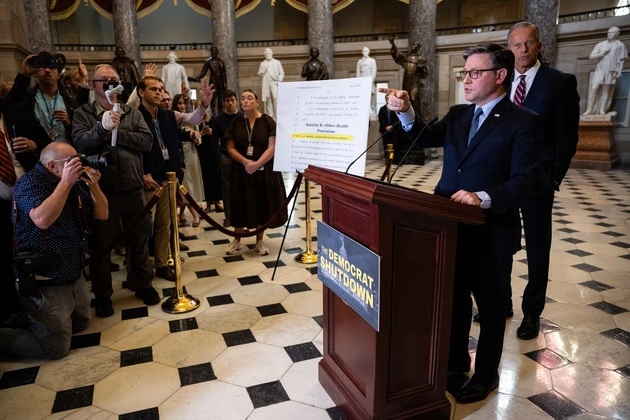The current shutdown of the U.S. federal government has become the second-longest in history. On October 22, it surpassed the 21-day shutdown of 1995–1996, when the budget battle turned into a tool of political brinkmanship. Back then, Republicans led by Newt Gingrich introduced a spending bill with deep cuts to social programs—something President Bill Clinton flatly rejected. Clinton refused to sign it, and only after late-night negotiations did the two sides reach a compromise. “We have to stop this,” pleaded Republican Senate leader Bob Dole. “This is getting a little silly.”
This time, there is no such sense of urgency. The House of Representatives has not convened in full since mid-September—two weeks before the shutdown began on October 1. Speaker Mike Johnson insists Republicans have done their part by approving a temporary measure that keeps spending at current levels. But Democrats have already rejected it 12 times in the Senate, demanding an extension of health insurance subsidies set to expire at the end of the year. According to a YouGov poll, most Americans still blame Republicans for the shutdown, though frustration with both parties is growing.
Neither Democrats nor Republicans appear willing to back down. Despite initial fears about economic fallout, the situation has proved surprisingly manageable. Donald Trump has taken steps that some call unlawful to ease the impact. The Defense Department, for instance, reallocated about $8 billion to pay 1.3 million service members. Some employees of ICE, the FBI, and the Department of Homeland Security also appear to be receiving pay. The president further announced that he would direct tariff revenues toward the food assistance program for low-income mothers and children and resume $3 billion in payments to farmers. “Trump is doing everything he can to make the shutdown as manageable as possible,” said one Republican congressional aide.
At the same time, the administration is trying to strike at Democrat-run regions. It has frozen or canceled about $28 billion in funding for projects located mainly in those areas. Office of Management and Budget Director Russell Vought has attempted to fire 4,100 federal employees and plans to cut at least 10,000 jobs. Democrats, however, remain unfazed: they argue the threats are empty, claiming the layoffs were planned even before the shutdown. “They were firing people left and right long before the government stopped,” said Democratic Senator Dick Durbin.

The White House Uses the Shutdown as a Tool to Purge the Bureaucracy
The Trump Administration Fires Thousands of Officials, Citing a Fight Against the “Woke Bureaucracy”

Trump Uses the Shutdown as a Tool to Consolidate Personal Power
It Is Part of a Systematic Campaign to Concentrate Authority
Most Americans have yet to feel the impact. Federal employment accounts for less than 2% of all jobs, and the usual inconveniences of a shutdown have been eased—for instance, national parks remain open by decision of the administration.
The longer the crisis drags on, the more tangible the economic losses will become. According to Oxford Economics, each week of the shutdown reduces annual GDP by 0.1–0.2 percentage points. Moreover, starting November 1, several states could run out of funding for the SNAP food assistance program, which provides millions of Americans with groceries. That prospect may finally push lawmakers toward an agreement.
Some attempts at compromise are already under way. Senate Republican leader John Thune has proposed holding a vote to extend health subsidies, but only after the government reopens. Democrats, however, remain skeptical: Trump’s repeated efforts to undo spending already approved by Congress have left them doubtful that the president won’t ignore or overturn a new budget with the help of his loyal majority. And while such a standoff might have seemed absurd in the 1990s, it has now become Washington’s new normal.
